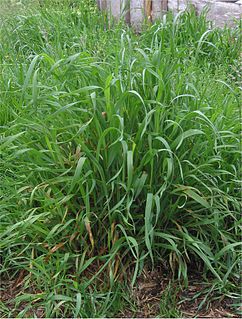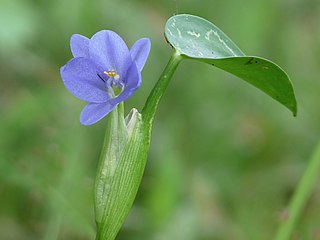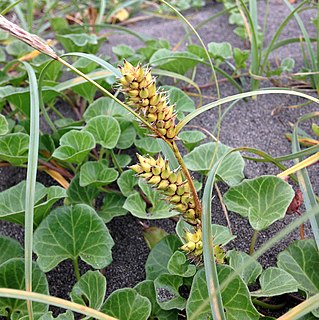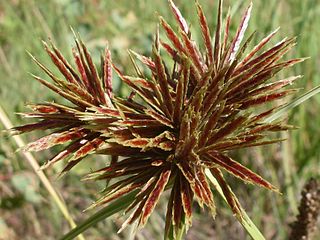
Weed control is the botanical component of pest control, which attempts to stop weeds, especially noxious weeds, from competing with desired flora and fauna including domesticated plants and livestock, and in natural settings preventing non native species competing with native species.

The Cyperaceae are a family of graminoid (grass-like), monocotyledonous flowering plants known as sedges. The family is large, with some 5,500 known species described in about 90 genera, the largest being the "true sedges" genus Carex with over 2,000 species.

Ornamental grasses are grasses grown as ornamental plants. Ornamental grasses are popular in many colder hardiness zones for their resilience to cold temperatures and aesthetic value throughout fall and winter seasons.

Elymus repens, commonly known as couch grass, is a very common perennial species of grass native to most of Europe, Asia, the Arctic biome, and northwest Africa. It has been brought into other mild northern climates for forage or erosion control, but is often considered a weed.

Ambrosia trifida, the giant ragweed, is a species of flowering plant in the sunflower family. It is native to North America, where it is widespread in Canada, the United States, and northern Mexico.

Cyperus polystachyos, also known as Pycreus polystachyos and commonly known as bunchy sedge, many-spiked sedge, or Texas sedge, is a herbaceous species in the family Cyperaceae, widespread in tropical and subtropical areas around the world, sometimes extending its range into temperate regions. In the United States, it has been reported from a region from Texas to Maine.

Cyperus eragrostis is a species of sedge known by several common names, including tall flatsedge, nutgrass, tall nutgrass, umbrella sedge, chufa, Earth almond, zula nuts, edible galingale and pale galingale.

Sulfentrazone is a chemical used as a herbicide. It is the active ingredient in Dismiss as well as Solitare herbicides. It controls weeds by disrupting membranes and inhibits photosynthesis in plants commonly known as PPO Inhibition. Sulfentrazone is received in the plants through the roots of the plants. As the plants come out of the soil, they die after exposure to light. It also works of foliar contact causing rapid desiccation. Sulfentrazone kills annual and perennial sedges, cool season grasses(Poa annua, Poa trivialis) The labels on Sulfentrazone product from Ortho indicate use on Well established turf grasses. Cool Season Grasses: Creeping Bentgrass, Fine & Tall Fescue, Perennial Ryegrass, Kentucky & Rough Bluegrass. Warm Season Grasses: Bahiagrass, Bermudagrass, Buffalograss, Carpetgrass, Centipedegrass, Kikuyugrass, Seashore Paspalum, St. Augustinegrass, Zoysiagrass.

Carex lasiocarpa is a broadly distributed species of wetland sedge sometimes known as woollyfruit sedge or slender sedge. It is considered a species of Least Concern by the IUCN Red List due to its extensive range with many stable populations.

Heliotropium amplexicaule is a species of heliotrope known by several common names, including clasping heliotrope, blue heliotrope, and summer heliotrope. It is native to South America, especially Argentina, but it is known on several other continents where it is an introduced species, and in some areas such as eastern Australia, a noxious weed.

Kyllinga is genus of flowering plants in the sedge family known commonly as spikesedges. They are native to tropical and warm temperate areas of the world, especially tropical Africa. These sedges vary in morphology, growing to heights from 2 centimeters to a meter and sometimes lacking rhizomes. They are closely related to Cyperus species and sometimes treated as part of a more broadly circumscribed Cyperus.

Tussock grasses or bunch grasses are a group of grass species in the family Poaceae. They usually grow as singular plants in clumps, tufts, hummocks, or bunches, rather than forming a sod or lawn, in meadows, grasslands, and prairies. As perennial plants, most species live more than one season. Tussock grasses are often found as forage in pastures and ornamental grasses in gardens.

A weed is a plant considered undesirable in a particular situation, "a plant in the wrong place". Examples commonly are plants unwanted in human-controlled settings, such as farm fields, gardens, lawns, and parks. Taxonomically, the term "weed" has no botanical significance, because a plant that is a weed in one context is not a weed when growing in a situation where it is in fact wanted, and where one species of plant is a valuable crop plant, another species in the same genus might be a serious weed, such as a wild bramble growing among cultivated loganberries. In the same way, volunteer crops (plants) are regarded as weeds in a subsequent crop. Many plants that people widely regard as weeds also are intentionally grown in gardens and other cultivated settings, in which case they are sometimes called beneficial weeds. The term weed also is applied to any plant that grows or reproduces aggressively, or is invasive outside its native habitat. More broadly "weed" occasionally is applied pejoratively to species outside the plant kingdom, species that can survive in diverse environments and reproduce quickly; in this sense it has even been applied to humans.

Ludwigia palustris is a species of flowering plant in the evening primrose family known by the common names marsh seedbox, Hampshire-purslane and water purslane. This is an aquatic or semiaquatic perennial herb which grows in moist to wet to flooded areas. It is sometimes a weed. The species epithet palustris is Latin for "of the marsh" and indicates its common habitat.

Monochoria vaginalis is a species of flowering plant in the water hyacinth family known by several common names, including heartshape false pickerelweed and oval-leafed pondweed.

Cyperus trachysanthos is a rare species of sedge known by the common names pu`uka`a and sticky flatsedge. It is endemic to Hawaii, where it is known from Kauai and Oahu. It was known from Niihau, Molokai and Lanai, but it has been extirpated from these islands. It is a federally listed endangered species of the United States.

Gahnia sieberiana, commonly known as the red-fruit saw-sedge, is a tussock-forming perennial plant in the family Cyperaceae, endemic to Australia. It is a widespread plant that favours damp sunny sites. Many insect larvae have been recorded feeding on the red-fruit saw-sedge. It may grow over 2 metres tall.

Kyllinga nemoralis, the white water sedge or whitehead spikesedge, is a plant species in the sedge family, Cyperaceae. It is found in shaded meadows, rock crevices and road sides.

Carex pumila, commonly known as strand sedge or spreading sedge, is a species of sedge of the family Cyperaceae.

Cyperus congestus, commonly known as dense flat-sedge or clustered flat-sedge, is a sedge of the family Cyperaceae that is native to southern Africa mostly in South Africa, Lesotho and Namibia.





















